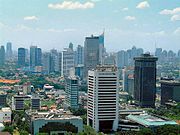
n the 1960s, the economy deteriorated drastically as a result of political instability, a young and inexperienced government, and ill-disciplined economic nationalism, which resulted in severe poverty and hunger. Following President Sukarno's downfall in the mid-1960s, the New Order administration brought a degree of discipline to economic policy that quickly brought inflation down, stabilized the currency, rescheduled foreign debt, and attracted foreign aid and investment. Indonesia is Southeast Asia's only member of OPEC, and the 1970s oil price raises provided an export revenue windfall that contributed to sustained high economic growth rates. Following further reforms in the late 1980s, foreign investment flowed into Indonesia, particularly into the rapidly developing export-orientated manufacturing sector, and from 1989 to 1997, the Indonesian economy grew by an average of over 7%.
Indonesia was the country hardest hit by the East Asian financial crisis of 1997–98. Against the US dollar, the currency dropped from about Rp. 2,000 to Rp. 18,000, and the economy shrunk by 13.7%. The rupiah has since stabilized at around Rp. 10,000, and there has been a slow but significant economic recovery. Political instability since 1998, slow economic reform, and corruption at all levels of government and business, have contributed to the patchy nature of the recovery. (Transparency International, for example, ranked Indonesia 130th out of 163 countries in its 2006 Corruption Perceptions Index). GDP growth, however, exceeded 5% in both 2004 and 2005, and is forecasted to increase. This growth rate, however, is not enough to make a significant impact on unemployment, and stagnant wages growth, and increases in fuel and rice prices have worsened poverty levels. As of 2006, an estimated 17.8% of the population live below the poverty line, and 49.0% of the population live on less than US$2 per day.
Labels: Economy